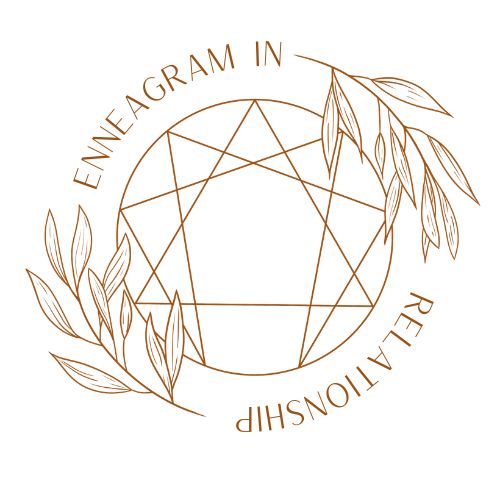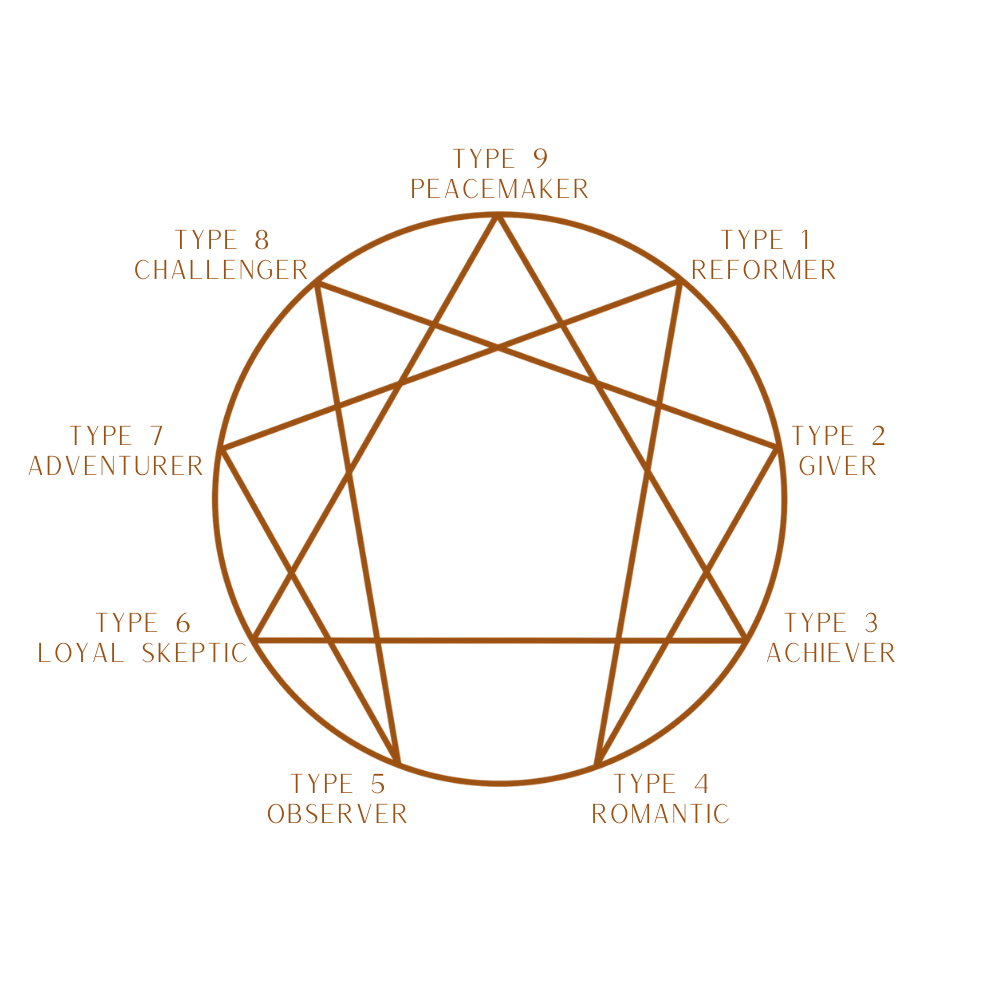Intro to the Enneagram
What is the Enneagram?
Your core type
Levels of consciousness
Centers of intelligence
Wings
Arrows
Subtypes
What is the Enneagram?
The Enneagram is a powerful system that supports us in living a more conscious and connected life.
The nine-pointed Enneagram symbol, stemming from the Greek word ennea (nine) and gram (something written or drawn), identifies nine distinct human type structures. Each type has an automatic way of thinking, feeling, and acting motivated by their different perceptions of the world. But the Enneagram isn’t just a personality typology with a list of character traits, it’s a guide for growth that creates lasting change. It takes the limiting beliefs, habitual behaviors, and coping strategies that make up our type structure and opens us up to alternative ways of being that exist beyond the limited perceptual lens we've been living through. It doesn't tell us who we are, it shows us who we've taken ourselves to be, and how to find freedom from the struggles that we face when we are living from that contracted place.
Ultimately, it allows us to awaken to who we really are, heal with compassion what has been holding us back, and live as the truest version of ourselves.
Your core type
This is the type that you operate from on a daily basis and have your entire life. You have one core type. With that being said, our type is not fixed, it's fluid. Meaning that while we are always our core type, within it we have our type structure and our True Self. From an Enneagram perspective, we are born with an inherent temperament that is impacted in early childhood by our interpretation of our environment, this is where we developed limiting beliefs, habitual behaviors, and coping strategies in order to deal with life according to our experiences. In nine unique ways, the type structure has been put in place to protect us. While the type structure is a part of who we are, it not all of who we are. The goal of this work is not to transcend the it, but to befriend it, to understand it, to be in relationship with it, and to TRANSFORM it - through love. We don’t want to shame this part of us, fear this part of us, or be angry with this part of us because it really is trying to help us. As you work with the Enneagram you will begin to see that every single struggle we have is an offering for healing, not a sentence for suffering. Becoming aware of the patterns of our type structure creates more choice, and that choice allows us to live our Truth.
Levels of consciousness
Also called levels of development, are a measure of identification with our type structure and offer us a guide for growth in our type. As we move up the levels, what we are really doing is waking up. We're going from an unaware state to an aware state, allowing us to live a more conscious life. Our type structure when we are unaware or asleep to our true nature creates an automatic way of being in the world that is rooted in fear and causes us to act in ways that are self-limiting. As we learn who we are underneath the layers of type structure, we can then liberate ourselves and find the freedom we have been looking for. The levels of consciousness are one of the many ways that the Enneagram supports our continuous expansion.
Centers of Intelligence
The Enneagram shows us that we have access to three centers of intelligence – the head, the heart, and the body. Each center has three types situated in it. We have access to all centers, but our type automatically operates from one first. As we grow in our capacity, our power to connect to all three centers increases, letting us live from a more balanced state.
Head Center - Types 5, 6, 7
• mental intelligence
• "thinking" center
• know through logic and thought
• core emotion: fear
• concerns: safety, certainty, confidence
• want: security
• focus: developing strategies
Heart Center - Types 2, 3, 4
• emotional intelligence
• "feeling" center
• know through mood and tone
• core emotion: sadness
• concerns: love, connection, approval
• want: validation
• focus: creating an image
Body Center - Types 8, 9, 1
• kinesthetic intelligence
• "doing" center
• know through physical sensations and gut instinct
• core emotion: anger
• concerns: worth, comfort, belonging
• want: autonomy
• focus: gaining control
Wings
The number to each side of your core type are your wings, therefore each type has two wings. Whichever wings your type has helps identify specific challenges, opportunities, and areas for growth. Working with our wings is another way the dynamic system of the Enneagram creates balance within us and for us. When we consciously integrate both wings it rectifies distortions that are preventing us from accessing our fullest potential.
Arrows
The two lines connected to your type are resource points, commonly known as stress and security. Moving towards our security point occurs when we are feeling safe and relaxed. Moving towards our stress point occurs when we are feeling pressured and overwhelmed. We want it to be clear that BOTH lines can be resource points, as both directions serve our growth. It's important to understand that these moves along the lines can be another way our type structure keeps us stuck in the same cycles if we don't consciously choose how to respond instead. In nine different ways, our type structure can find methods to bypass real healing if we're not aware of what's happening. What our lines have the potential to do is help us connect to the deepest, richest, fullest versions of ourselves by allowing us to integrate the qualities that can only be discovered when we are committed to the process of transformation. Working with our security point helps us unlock our hearts capacity to be receptive in life by healing our childhood wounds, and working with our stress point helps us unblock hidden strengths and qualities by accessing untapped intelligence. When we merge what we learn from our resource points with our core type, we open up to a higher and healthier level of consciousness. Making these moves with intentional awareness doesn't keep us away from ourselves, as it does if we are moving there unconsciously, rather it brings us back to our True Self so we can move forward in life - if we're willing to do the inner work involved.
Subtypes
As humans, we have three basic survival instincts – self-preservation, one-to-one (sexual), and social, which influence our behavior and how we get our needs met. When these instincts blend with our types emotional drive (vice or passion), it creates our subtype. Many of our values are located in our subtype, which makes learning about them of extra importance in relationships. The inner work with the subtypes allows us to not be driven by distortions but rather, led by love.
Self-preservation
• Motivated by a need to protect themselves
• Energy goes to physical needs such as security, comfort, safety, food, and shelter
• Desire to feel alive
One-to-one
• Motivated by a need to bond directly with someone
• Energy goes to developing special close connections, often engaging in relationships with intensity
• Desire to feel loved
Social
• Motivated by a need to be a part of the group
• Energy goes community, group membership, participation, and having a social role
• Desire to feel belonging
The knowledge and information we share on this website is adapted from our training with The Narrative Enneagram, The Enneagram Institute, our professional experience with clients, and our personal relationships. Thank you to our teachers Renée Rosario, Terry Saracino, Peter O’Hanrahan, Marion Gilbert, Christopher T. Copeland, and Russ Hudson. As well as Helen Palmer and David Daniels, without whom none of this would be possible.

